
Understanding the TyG Index and Its Significance
The Triglyceride-Glucose (TyG) index has emerged as an important indicator in medical research, particularly concerning metabolic disorders. As a composite measure of triglycerides and glucose levels, it offers a new perspective on the risk assessment of several health issues, including cardiovascular disease and diabetes. Recent research highlights its potential association with periodontal disease, opening up new avenues for understanding oral health's connection to systemic health.
Link Between TyG Index and Periodontitis: What the Research Shows
According to recent studies, a higher TyG index correlates with an increased risk of periodontitis, a common but serious gum disease characterized by inflammation and loss of supporting structures around teeth. This relationship emphasizes the significance of effective control of metabolic parameters, as maintaining balanced glucose and triglyceride levels could possibly mitigate the risks associated with periodontal disease.
Broader Implications on Health: How Oral Health Affects Overall Wellness
The interrelationship between oral health and systemic diseases is well-documented. Conditions like diabetes can exacerbate periodontal disease, while chronic inflammation associated with gum disease may influence the progression of metabolic disorders. The TyG index thus serves not only as a biomarker for metabolic health but also a potential predictor for periodontal conditions, illustrating the importance of a holistic approach to health.
What This Means for Patients and Healthcare Providers
For healthcare practitioners, the findings regarding the TyG index underscore the need for vigilance in monitoring metabolic health indicators as a preventive measure against periodontal conditions. Regular screenings for metabolic disorders could lead to early interventions, potentially reducing the burden of periodontitis among at-risk populations.
Future Research Directions: Exploring Uncharted Territory
Ongoing research aims to further define the mechanisms underlying the link between the TyG index and periodontal disease. Future studies may focus on intervention strategies, exploring how lifestyle modifications, dietary changes, and medical management of glucose and triglyceride levels can positively impact both metabolic and oral health. As scientists and dental experts delve deeper into these relationships, they may uncover valuable insights that could lead to enhanced prevention strategies for periodontal disease.
Practical Insights: Monitoring Your TyG Index
Individuals concerned about their oral health and metabolic status might consider discussing the importance of the TyG index with their healthcare provider. Regular check-ups that include assessments of triglyceride and glucose levels can empower patients to take proactive measures in both oral and overall health.
Concluding Thoughts: The Importance of Interconnected Health
As we continue to explore the complexities of health and disease, the association between the TyG index and periodontitis serves as a reminder of the importance of a comprehensive health approach. By understanding connections between various health indicators, we can foster a more integrated healthcare model that prioritizes patient education and preventive care.
 Add Row
Add Row  Add
Add 




Write A Comment